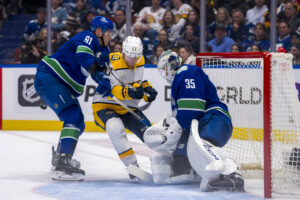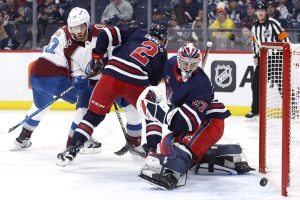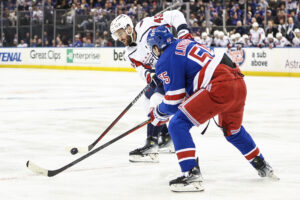The Ottawa Senators have jumped out the gate to a blistering 7-3-0 start, and while credit for this record extends from the coaching staff to the entire team, there have been certain members who have stood out for better or for worse. There were those whose performances were markedly superior, as well as those whose performances were forgettable. These are the Ottawa Senators stars and disappointments through the first 10 games.
Ottawa Senators Stars and Disappointments: The First 10 Games
Stars
Mike Hoffman
Mike Hoffman’s 39 shots on goal are good for sixth in the league. His 49.77 Corsi-for percentage is third among forwards on the team, behind just Chris Neil and Bobby Ryan. His 17.3 individual Corsi-for per 60 minutes ranks 31st in the league among skaters with at least 100 minutes played. Although Hoffman has struggled to put the puck in the back of the net this season, his 5.1 shooting percentage is a far cry from his historic norm of 12.5-13%. All in all, he’s been one of the Senators best forward. He was snake bitten to start the season but with two goals in his last three games it looks as though those issues are behind him.
Chris Wideman/Mark Borowiecki
Chris Wideman and Mark Borowiecki are paired here for their excellent early season work together. Wideman actually leads the team after 10 games in raw Corsi-for percentage at 51.46, and is followed closely by his partner. Boroweicki actually boasts the lowest expected goals against per 60 minutes among team defensemen, and Wideman boasts the second best.
Yes, their deployment has been cushier than a Sleep Country commercial, but their result is a far cry from the dumpster fire that was last season.
Kyle Turris
The Senators number one center has been phenomenal to start the season. After watching Kyle Turris hobble across the ice on one leg for the tail end of last season, to see the British Columbia native at full health is a welcome sight. His five goals, and two assists, place him in a tie for second among Senators points leaders, but none can match his mark in goals.
His return has also boosted the Senators power play. Although the special teams unit has struggled this season, particularly at home, Turris accounts for the third highest rate of shot attempts with 27.7 individual Corsi-for/60. He’s topped by Hoffman and Dion Phaneuf. For his efforts he has one of their three power-play markers.
Craig Anderson
In 438 minutes of ice time, Craig Anderson has stopped 208 of 224 shots. He has averaged a .929 save percentage and posted two shutouts. He’s done it while backstopping the ninth most porous defences in the league – one that allows 59 attempts against per 60 minutes. And he’s done it all while struggling with a wife who has been diagnosed with cancer.
He was the NHL’s most recent First Star of the Week after posting a pair of back-to-back shut outs. He has been the more than the Senators backstopper, he’s been their backbone. He’s been a pillar of strength, even when he needed them more than they needed him. Anderson has been inspirational this season. To simply call him one of the Senators stars is an understatement.
Honorable Mentions
Ryan Dzingel gets honorable mentions. because has made his way into the top six. The speedy winger has been a vital part of the Senators attack. Dzingel is third on the team in points, with four goals, and three assists, and sits just two back of team leader Erik Karlsson. Not bad for a player with just 40 games of NHL experience.
Disappointments
Not everyone within the Senators organisation has been off to such strong a start. There have also been a few disappointments in the mix as well.
Team Management
Anyone who follows the Ottawa Senators knows about Thomas Chabot, and the Sens management’s perplexing treatment of him. The 18th overall pick in the 2015 NHL Draft seemingly made the team out of training camp. He ended up only playing about seven minutes of ice time through the Senators first nine games of the year before he was sent back down. His only action was during the Sens Oct. 18th win vs. the Arizona Coyotes.
Chabot is a very talented defenseman, as evidenced by his play in junior. However, like many other young defensemen, he is not without his flaws and needs to learn how to better handle himself in his own end and to compete for every puck.
While practising and being on the road with the big club is certainly an asset to any young player’s development, there is no substitution for in-game experience. If Ottawa wanted to see Chabot grow and improve he has to play, and better to play the games in junior than sitting in the press box watching in the NHL. Which makes the Sens move all the more puzzling.
General manager Pierre Dorion was quoted as saying, after finally sending Chabot down to the QMJHL, that “It’s all about the two points and about dressing the best lineup to get (wins)… It’s not a development league.”
Fair enough, the Sens need to put the best players on the ice to win, and Chabot wasn’t one of those players. But if he isn’t playing, why waste his time? He could have been working on his game in junior, and gaining more experience and maturity in a leadership role.
Dion Phaneuf/Cody Ceci
To just pile on a bit more to the question marks surrounding the Sens defense, Ottawa’s second pairing of Phaneuf and Cody Ceci have been shaky so far through the first 10 games.
Ceci seems to just be unsure of himself, and this could be due inexperience or still adjusting to the new coaching staff. Phaneuf, for his part, just seems to be a step behind. The analytics numbers on the pair don’t look too pretty either. Separately, they have the two worst even-strength corsi-for percentages of the six defensemen on the Sens, at 42.65% for Phaneuf and 43.73% for Ceci.
Together, they are the worst in the league for pairings with a minimum of 100 minutes together, posting a corsi-for percentage of 41.47. To add to that, their Corsi-shooting percentage is a paltry 1.87%, meaning that off all the shots that are directed at their opponent’s goal while they’re on the ice, only one per cent end up as goals.
Obviously, the sample size isn’t very big, as it’s only 10 games into the season, but this trend is not something that the Sens would like to continue seeing from their second pairing, especially with the uncertainty surrounding Ottawa’s netminders.
Andrew Hammond
This was a bit of a tough call, as Andrew Hammond’s playing time this year has been limited. As of now he is still out with a lower body injury, but he hasn’t done anything this year to show fans or management that he’ll be able to come in and win the team some games. While Hammond did have a hot streak a few years ago, going 20-1-2 during the 2014-2015 season, it might be time to acknowledge that that’s exactly what it was; a hot streak and nothing more. He followed that up with a 7-11-4 record last year, posting a goals-against average of 2.65 and this season has so far let in 6 goals on 23 shots. A backup goalie doesn’t necessarily have to be lights-out, but they need to at least be dependable.
The goaltending situation in Ottawa is a bit murky at the moment, with Craig Anderson’s family situation in limbo, Hammond being injured, and the Sens recently trading for Mike Condon from the Pittsburgh Penguins. If Condon shows that he can be a serviceable backup, management might start thinking about moving Hammond, especially considering Condon makes less than half of Hammond’s salary, $575,000 vs. $1.35 million. Regardless of what happens in Ottawa’s crease, Hammond needs to play very well when he returns from injury, or he might find himself out of a job.
Main Photo.






